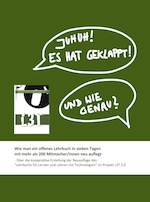 Es ist nun soweit, die Dokumentation des Erstellungsprozesses rund um das Lehrbuch Lernen und Lehren mit Technologien ist jetzt sowohl online verfügbar bzw. als Printexemplar als Band 7 unserer O3R-Reihe erschienen.
Es ist nun soweit, die Dokumentation des Erstellungsprozesses rund um das Lehrbuch Lernen und Lehren mit Technologien ist jetzt sowohl online verfügbar bzw. als Printexemplar als Band 7 unserer O3R-Reihe erschienen.
Wir bedanken uns bei allen Autorinnen und Autoren und natürlich auch bei allen Mitwirkenden für eine spannende Woche L3T 2.0.
Klappentext:
L3T ist die Kurzform für das preisgekrönte und frei zugängliche “Lehrbuch für Lernen und Lehren mit Technologien” (https://l3t.eu). Im Sommer 2013 wurde das Buch im Rahmen des Projekts “L3T 2.0″ gänzlich überarbeitet und erweitert. Dabei wurde ein neuartiger Weg eingeschlagen: Innerhalb von sieben Tagen, vom 20. bis 28. August 2013 wurde das Buch in L3T-Camps und per Online-Kommunikation und -Kollaboration im deutschsprachigen Europa überarbeitet bzw. neu erstellt. Die neue Ausgabe erlaubt zudem Modifizierungen der Texte, kann also noch flexibler in der Lehre eingesetzt werden können.
In diesem Buch wird beschrieben, wie im Projekt „L3T 2.0“ vorgegangen wurde und welche Aufgaben verteilt wurde. Außerdem werden ausführlich die Ergebnisse einer Zwischen- und Abschlussbefragung der 268 Mitmacher/innen vorgestellt. Die (Selbst-) Evaluation mündet schließlich in der Formulierung in Empfehlungen für Nachahmer/innen. Das Buch sollte für all diejenigen von Interesse sein, die im Bereich der offenen Bildungsressourcen, Buchsprints oder offener Buchprojekte Erfahrungen und Berichte suchen, um sich für eigene Projekte inspirieren zu lassen.
Mit Beiträgen von Martin Ebner, Jennifer-Carmen Frey, Anett Hübner, Magdalena Noffke, Hannes Rothe und Sandra Schön
Zitation: Ebner, M., Frey, J., Hübner, A., Noffke, M., Rothe, H., Schön, S. (2014) Wie man ein offenes Lehrbuch in sieben Tagen mit mehr als 200 Mitmacher/innen neu auflegt, Book On Demand, Norderstedt, https://o3r.eu

![[CfP] Learning Analytics](https://elearningblog.tugraz.at/wp-content/uploads/2013/12/picture.jpg)